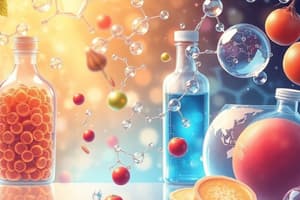Podcast
Questions and Answers
What are carbohydrates
What are carbohydrates
They are carbon molecules rich in hydroxyl groups
What is the empirical formula of carbohydrates
What is the empirical formula of carbohydrates
(CH20)n
Carbohydrates were recognized as?
Carbohydrates were recognized as?
Important fuels and structural components
Carbohydrates are central to ?
Carbohydrates are central to ?
Carbohydrates are the basis of what?
Carbohydrates are the basis of what?
What does carbohydrates help to define in cells
What does carbohydrates help to define in cells
Carbohydrates are crucial for the development and functioning of all organisms as what?
Carbohydrates are crucial for the development and functioning of all organisms as what?
Monosaccharides are also known as
Monosaccharides are also known as
Monosaccharides serve as what?
Monosaccharides serve as what?
Monosaccharides has how many hydroxyl groups
Monosaccharides has how many hydroxyl groups
What are the classication of monosaccharides based on functional groups
What are the classication of monosaccharides based on functional groups
What is the classication of monosaccharides based on number of carbon
What is the classication of monosaccharides based on number of carbon
What are the most common hexose
What are the most common hexose
What is the sweetest chemical known and where is it found
What is the sweetest chemical known and where is it found
When beta D fructopyranose is heated what does it form?
When beta D fructopyranose is heated what does it form?
What is the difference between the sweetness of fructose and sucrose
What is the difference between the sweetness of fructose and sucrose
What are the properties of carbohydrates
What are the properties of carbohydrates
Carbohydrates are extremely soluble in water despite their high molecular weight why?
Carbohydrates are extremely soluble in water despite their high molecular weight why?
Glucose reacts with fehling solution
Glucose reacts with fehling solution
Glucose reacts haemoglobin to form what
Glucose reacts haemoglobin to form what
How are disaccharides formed
How are disaccharides formed
How are polysaccharides formed
How are polysaccharides formed
What are the 2 forms of starch in plant
What are the 2 forms of starch in plant
What is amylose
What is amylose
What is amylopectin
What is amylopectin
Polysaccharides play vital roles in ?
Polysaccharides play vital roles in ?
What is the nutritional reservoir in plants
What is the nutritional reservoir in plants
What is the most abundant organic compound on earth and where is it found
What is the most abundant organic compound on earth and where is it found
What is another names for pectin
What is another names for pectin
How does soluble fiber aid digestion
How does soluble fiber aid digestion
What does soluble fiber do
What does soluble fiber do
What does insulin consist of
What does insulin consist of
What is inulin used for
What is inulin used for
What is the unique property of carbohydrates that gives them the ability to have many functions
What is the unique property of carbohydrates that gives them the ability to have many functions
Why are monosaccharides much more soluble in water than molecules of similar molecular weight
Why are monosaccharides much more soluble in water than molecules of similar molecular weight
What are glycosidic bond
What are glycosidic bond
List the types of disaccharides
List the types of disaccharides
What is sucrose
What is sucrose
What are lactose
What are lactose
What are maltose
What are maltose
What are cellobiose
What are cellobiose
Flashcards
Carbohydrates
Carbohydrates
Carbon-rich molecules with abundant hydroxyl groups.
Monosaccharides
Monosaccharides
The simplest form of carbohydrates, often referred to as simple sugars.
Disaccharides
Disaccharides
A group of carbohydrates consisting of two monosaccharides joined together.
Polysaccharides
Polysaccharides
Signup and view all the flashcards
Empirical Formula (CH2O)n
Empirical Formula (CH2O)n
Signup and view all the flashcards
Aldoses and Ketoses
Aldoses and Ketoses
Signup and view all the flashcards
Trose, Tetrose, Pentose, Hexose, Heptose
Trose, Tetrose, Pentose, Hexose, Heptose
Signup and view all the flashcards
Glucose
Glucose
Signup and view all the flashcards
Fructose
Fructose
Signup and view all the flashcards
Relative Sweetness of Sugars
Relative Sweetness of Sugars
Signup and view all the flashcards
Amylopectin
Amylopectin
Signup and view all the flashcards
Amylose
Amylose
Signup and view all the flashcards
Cellulose
Cellulose
Signup and view all the flashcards
Pectin
Pectin
Signup and view all the flashcards
Inulin
Inulin
Signup and view all the flashcards
Insulin
Insulin
Signup and view all the flashcards
Roles of Carbohydrates in Cells
Roles of Carbohydrates in Cells
Signup and view all the flashcards
Carbohydrates Defining Cellular Beauty and Functionality
Carbohydrates Defining Cellular Beauty and Functionality
Signup and view all the flashcards
Fuel and Information Rich Molecules
Fuel and Information Rich Molecules
Signup and view all the flashcards
Basis of Human Blood Groups
Basis of Human Blood Groups
Signup and view all the flashcards
Glycosidic Linkage
Glycosidic Linkage
Signup and view all the flashcards
Hydrolysis
Hydrolysis
Signup and view all the flashcards
Soluble Fiber
Soluble Fiber
Signup and view all the flashcards
Insoluble Fiber
Insoluble Fiber
Signup and view all the flashcards
Reaction with Fehling's Solution
Reaction with Fehling's Solution
Signup and view all the flashcards
Glycosylated Hemoglobin
Glycosylated Hemoglobin
Signup and view all the flashcards
Glycogen
Glycogen
Signup and view all the flashcards
Glycation
Glycation
Signup and view all the flashcards



